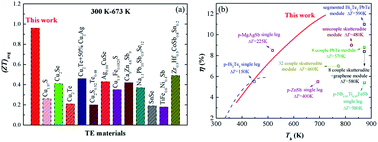Achieving high room-temperature thermoelectric performance in cubic AgCuTe†
Abstract
Although there has been significant progress in developing high-temperature thermoelectric materials, seeking promising near-room-temperature candidates has been extremely difficult, and the discovery of such materials, which would be beneficial for low-grade waste-heat power generation and cooling near room temperature, has been rarely reported. Here we report the enhanced near-room-temperature performance (ZTmax = ∼1.1 at 350 K, ZTavg = ∼1.0 between 300 K and 673 K) of copper chalcogenide (AgCu)0.995Te0.9Se0.1 by successfully stabilizing the face-centered cubic (FCC) phase at room temperature. Surprisingly low lattice thermal conductivity (∼0.4 W m−1 K−1) and a good power factor (∼13.8 μW cm−1 K−2) are simultaneously achieved near room temperature due to the unique properties of the FCC phase. A competitive conversion efficiency of 11% is obtained in a (AgCu)0.995Te0.9Se0.1-based single leg at a low temperature difference of 400 K. The high thermal stability and low operating temperature, combined with the economically competitive efficiency, will greatly promote the application of (AgCu)0.995Te0.9Se0.1-based devices in power generation from low- and medium-grade waste heat. The results also indicate a new strategy to improve the near-room-temperature performance and stability of copper chalcogenide thermoelectric materials and a new direction for further research.



 Please wait while we load your content...
Please wait while we load your content...